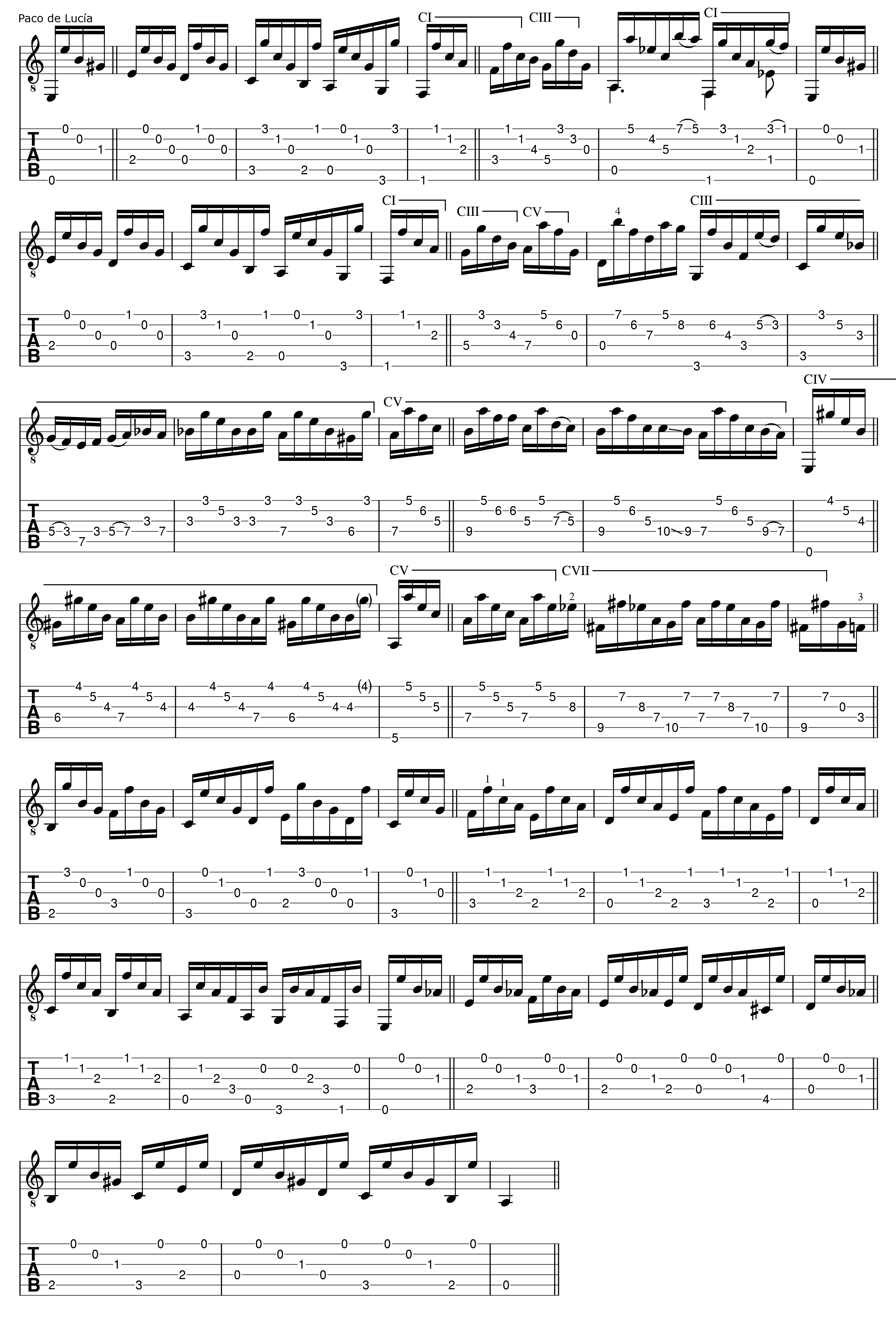
The following malagueñas falsetas are based on the rhythmic structure of the siguiriyas compás. The transcriptions are written in a three-part alternating time signature of 2/4, 6/8 and 1/4 counted "1 and 2 and 3 and uh 4 and uh 5 and." The thick bar lines indicate the beginning of each complete siguiriyas compás. The falsetas consist almost entirely of two basic arpeggio patterns: p-a-m-i for beats 1, 2 and 5, and p-a-m-i-p-a for beats 3 and 4.
Ramón Montoya appears to be the first to record this mechanism, as heard on the two-CD Sonifolk publication of his complete solo recordings (CD1 track 8). Notice that the falseta starts on the first long interval of the siguiriyas compás (beat 3). Toward the end, he slows down considerably and repeats the six-stroke pattern in the conclusion. Capo at first fret.

Niño Ricardo recorded a very similar idea in 1966 in his accompaniment of a jabera sung by el Chocolate. Variations appear in a malagueña from 1930 with la Andalucita ("Un niño recién nacido"), on his Hispavox solo recording and in a malagueña with Caracol ("Qué bonita era"). At the end of the first staff, the last arpeggio includes the open first string. At the end of the second staff, the open third string anticipates the change to the G9 chord. After the double bar at the end of the last staff there is no longer a strict rhythmic context, and the last two arpeggios are played freely. Capo at fifth fret.

Paco de Lucía recorded an excellent variation in 1967 for his malagueña "En la Caleta." This falseta not only reflects his general knowledge of the guitar and specific appreciation of Montoya and Ricardo but is also one of several arpeggiated falsetas from his early recordings (Viva La Unión, Reflejo de la luna) in which his development of traditional ideas is nothing short of astounding.
Unlike Montoya and Ricardo, he starts on the first short interval of the siguiriyas compás (beat 5). Notice the open third string in the second arpeggio. At the end of the first staff, he anticipates the F-G chord change, moving the barre on the last note of the arpeggio just before beat two. Notice that the open third string at the end of beat 2 is also present at the same point in the next staff. Fret the last two chords with your first three fingers (index to ring). The second staff is a repeat of the first but extends the conclusion into a higher register. This time, the last two chords are fretted with the last three fingers (middle to little). Notice that the transition between these chords involves five frets of difference: from the second string eighth fret (high G) to the sixth string third fret (low G). Slide down two frets from the high G (you can hear it in the recording) with your fingers in the same positions on the strings, move your middle finger to the third string and use your ring for the slur. In the third staff, the C7 chord is fretted with the first three fingers and the striking-hand thumb and index coincide on the third string. The first note of the arpeggio at beat five (the A of the F chord) is fretted with the ring finger. The repeated note on the second string was probably a mistake; it sounds better to play a normal arpeggio on the first three strings. In the following arpeggios, slide and slur with your little finger. In the fourth staff, the barred A minor chord at beat five should be fretted with the ring and little fingers in order to articulate the B7 chord that follows, where we see yet another example of anticipating the change, with the barre moving up two frets on the last note of the arpeggio. In the fifth staff, the last arpeggio of the B7 (fifth beat of first compás) includes the open third string and the opportunity to move your fretting hand down to first position. The fourth-string F of this arpeggio is barely audible in the recording and may actually be a slur on the open string. Toward the end of the seventh staff (second beat of second compás), one of the arpeggios is substituted for rhythmic counterpoint. The falseta ends on the open fifth string with the classic cierre of the malagueña. Capo at second fret.
